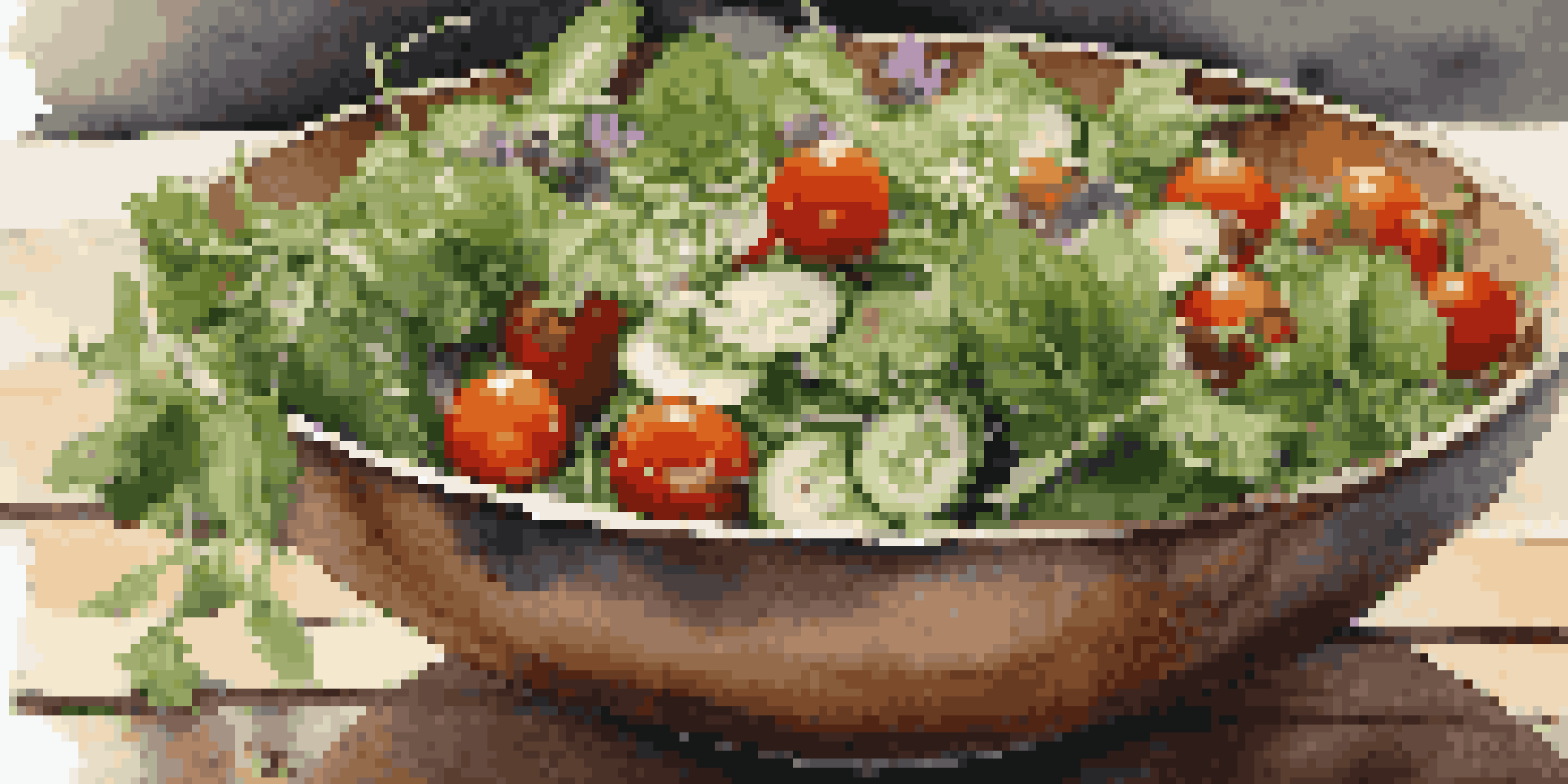Crafting Flavored Vinegars: Techniques for Gourmet Salads

Why Flavored Vinegars Are a Must for Gourmet Salads
Flavored vinegars add a delightful twist to your salads, elevating them from ordinary to extraordinary. They bring layers of flavor that can make even the simplest greens shine. Imagine drizzling a homemade basil-infused vinegar over a fresh tomato salad—it’s like a flavor explosion in every bite!
The secret of good cooking is, first, having a good stock, second, having a good vinegar, and third, having good seasoning.
Using flavored vinegars allows you to customize your dressings to suit your taste and the season. With a variety of herbs, fruits, and spices, the possibilities are endless. Plus, they’re a great way to use up leftover herbs from your garden or fridge, reducing waste while enhancing your culinary repertoire.
Incorporating these vinegars into your salads not only boosts flavor but also adds visual appeal. A vibrant raspberry vinegar can transform a basic spinach salad into a stunning centerpiece for your table. With just a splash, you can impress your guests and savor the satisfaction of gourmet dining at home.
Essential Ingredients for Crafting Flavored Vinegars
To create your own flavored vinegars, you’ll need a good quality base vinegar, like white wine or apple cider vinegar. These options provide a neutral yet tangy foundation that complements various flavors. Think of the vinegar as the canvas for your culinary masterpiece—it sets the stage for all the vibrant ingredients to shine.

Next, consider your flavoring agents. Fresh herbs, fruits, spices, and even garlic can infuse your vinegar with incredible taste. For instance, rosemary and garlic create a savory blend perfect for dressings, while strawberries and mint offer a refreshing, fruity profile. The key is to experiment and find combinations that excite your palate.
Flavored Vinegars Enhance Salads
Using flavored vinegars can transform ordinary salads into gourmet experiences with their vibrant tastes and visual appeal.
Finally, don't forget about the importance of time. Letting your vinegar steep for at least a week allows the flavors to meld beautifully. It’s like letting a fine wine breathe; the longer it sits, the more complex and delightful it becomes. Patience truly pays off in the world of flavored vinegars.
Step-by-Step: Making Your Own Flavored Vinegars
Making flavored vinegar at home is a straightforward process that anyone can master. Start by choosing your base vinegar and desired flavorings. For instance, if you’re in the mood for a citrusy touch, consider using orange peels and rosemary with white wine vinegar.
Cooking is like love. It should be entered into with abandon or not at all.
Once you have your ingredients, simply combine them in a clean glass jar. Fill the jar with vinegar, ensuring the ingredients are fully submerged to prevent spoilage. Seal it tightly and give it a gentle shake, which helps release the flavors immediately. It’s almost like making a potion—exciting and full of potential!
Place the jar in a cool, dark location and allow it to steep for a week or longer, shaking it occasionally. After the steeping period, strain out the solids using a fine mesh sieve or cheesecloth. Your homemade flavored vinegar is now ready to dress salads, drizzle over grilled vegetables, or even use as a marinade!
Choosing the Right Vinegar for Your Flavor Profile
Not all vinegars are created equal, and choosing the right one can significantly influence your final product. For light and fruity flavors, white wine vinegar or champagne vinegar works beautifully. Their subtle notes allow the added ingredients to shine without overpowering the palate.
On the other hand, if you’re aiming for a bold, robust flavor, consider using balsamic vinegar. Its rich, sweet undertones pair wonderfully with hearty ingredients like garlic and thyme. Think of balsamic as the deep bass in a symphony—grounding and harmonizing the more delicate flavors.
Easy Homemade Flavored Vinegars
Crafting your own flavored vinegars at home is a straightforward process that allows for endless customization and creativity.
Experimenting with different vinegars can lead to delightful surprises. For instance, using rice vinegar can introduce an Asian twist, perfect for salads featuring sesame or ginger flavors. The versatility of vinegars means you can tailor your creations to complement any dish.
Creative Flavor Combinations to Try
The beauty of crafting flavored vinegars lies in the endless combinations you can create. Consider infusing apple cider vinegar with cinnamon sticks and dried apples for a warm, autumn-inspired flavor. This combination is perfect for drizzling over roasted vegetable salads during the fall season.
For a refreshing summer twist, try steeping white wine vinegar with fresh peaches and basil. The sweetness of the peaches paired with the aromatic basil creates a delightful dressing for a mixed greens salad. It’s like capturing a summer picnic in a bottle!
Don’t shy away from experimenting with unexpected flavors, too. How about a spicy jalapeño-infused vinegar? This versatile option can add a kick to your salad dressings or even be used in marinades for grilled dishes. The key is to let your creativity flow and enjoy the process of discovery.
Storing and Using Your Flavored Vinegars
Once you’ve crafted your delicious flavored vinegars, proper storage is essential to maintain their freshness. Store them in a cool, dark place, like a pantry or cupboard, away from direct sunlight. If you’ve used fresh ingredients, aim to consume your vinegar within six months for the best flavor.
When it comes to using your flavored vinegars, the possibilities are virtually limitless. Use them as salad dressings, marinades, or even as a zesty addition to sauces. Just remember, a little goes a long way, so start with a small drizzle and adjust to taste.
Storage and Usage Tips
Proper storage of flavored vinegars ensures their freshness, while their versatility allows for use in dressings, marinades, and more.
You can also gift your homemade flavored vinegars in decorative bottles, complete with a label describing the flavors. This personal touch makes for a thoughtful present, especially for fellow food enthusiasts. Sharing your creations adds joy to the experience and inspires others to explore their culinary talents.
Elevating Everyday Salads with Flavored Vinegars
Flavored vinegars can effortlessly transform your everyday salads into gourmet experiences. Instead of reaching for store-bought dressings, try experimenting with your homemade varieties. You’ll be surprised at how a simple splash of flavored vinegar can enhance the overall taste and enjoyment of your meal.
Consider creating a salad that showcases seasonal ingredients paired with your flavored vinegar. For example, a summer salad with arugula, cherry tomatoes, and your basil-infused vinegar can highlight the freshness of the season. It’s about making the ingredients shine and celebrating the flavors available to you.

Finally, don’t forget the importance of presentation. A well-composed salad drizzled with your homemade vinegar not only tastes good but looks exquisite. By adding garnishes like edible flowers or nuts, you create a dish that’s as pleasing to the eyes as it is to the taste buds, making every meal feel like a special occasion.